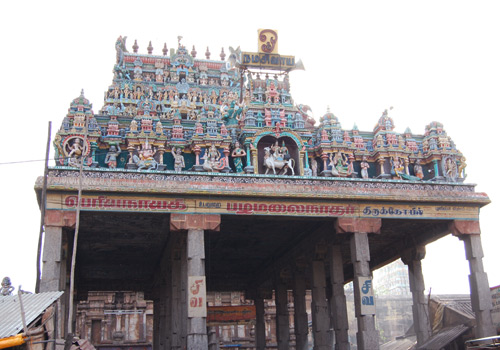Virudhachalam Viruthagirishwarar Temple | Tamilnadu Temple | விருத்தகிரீஸ்வரர்
The Sthala Vruksha is the Vanni tree. As per the Legends, that this is the Kalpaka tree which came to the Earth from the Heaven to worship the Lord. The Sthala Purana give an interesting account of the place. It confirms the antiquity of the place for here it is associated with the origin of the world. Brahma first created water, it was then that Lord Vishnu killed the Madhu-Kaidapas.
A Visit to this Temple is equated to a visit to the Kasi Temple at Varanasi.
Temple Phone No:- 04143-230203
Viruthagirishwarar Temple Timings: 6 AM to 12 Noon and 3.30 PM to 9 PM
Distance between Chennai and Virudhachalam is 227 Kms
Exploring the Divine Splendor of Virudhachalam’s Viruthagirishwarar Temple
Nestled in the heart of Tamil Nadu, amidst the serene landscapes and rich cultural tapestry of Virudhachalam, lies the Viruthagirishwarar Temple – a beacon of spiritual solace and architectural grandeur. This ancient temple, dedicated to Lord Shiva, stands as a testament to the profound spirituality and architectural ingenuity that has permeated Tamil culture for centuries. This article delves into the temple’s historical significance, architectural marvels, religious importance, and the festive celebrations that mark its calendar, offering a comprehensive exploration of this sacred site.
Historical Context and Legend
Viruthagirishwarar Temple, also known as Thiruviruthagireeswarar or Bala Kandeswarar Temple, is steeped in history and mythology. According to legend, the temple’s origins are connected to the divine play of Lord Shiva. It is believed that the presiding deity, Viruthagirishwarar (a form of Lord Shiva), manifested here to bless the sages and devotees. The name ‘Virudhachalam’ itself is derived from the Tamil words ‘Virutham’ (tree) and ‘Achalam’ (mountain), alluding to the ancient forest that once thrived here and the mountainous terrain that surrounds the temple.
The historical records and architectural styles suggest that the temple is several centuries old, with contributions from various dynasties like the Cholas, Pandyas, and Pallavas, who played significant roles in its construction and expansion. The inscriptions found within the temple premises offer insights into its rich past, including donations made by kings for its maintenance and development.
Architectural Grandeur
The Viruthagirishwarar Temple is an exemplary showcase of Dravidian architecture, characterized by its towering gopurams (gateway towers), intricately carved pillars, and sprawling courtyards. The main sanctum sanctorum houses the Shiva Lingam, representing Lord Viruthagirishwarar, which is revered by devotees from far and wide.
One of the architectural highlights is the temple’s Rajagopuram (the main temple tower), which stands tall, adorned with detailed carvings of deities, mythological creatures, and scenes from Hindu epics. The temple complex also houses shrines dedicated to various deities, including Goddess Parvati (worshipped here as Thiripurasundari), Lord Ganesha, and Lord Murugan, each located within beautifully crafted mandapas (pavilions).
The temple tank, known as Sivagangai Thirtham, is another significant feature, believed to possess healing properties. Devotees perform rituals and take holy dips in its waters, especially during auspicious occasions.
Religious Significance
The Viruthagirishwarar Temple is not just an architectural marvel but also a center of profound spiritual significance. It is revered as one of the sacred Shaivaite temples, attracting devotees who seek blessings and spiritual enlightenment. Virudhagiriswarar temple is associated with various legends that underscore its importance in Hindu mythology, including stories that highlight the power of penance, devotion, and the benevolence of Lord Shiva.
One of the unique aspects of worship here is the ritual of anointing the Lingam with a special mixture, which is believed to symbolize the soul’s purity and devotion. The temple also plays a crucial role in the observance of Shivaratri, a night dedicated to Lord Shiva, which sees the temple come alive with rituals, prayers, and devotional music.
Festivals and Celebrations
The temple’s calendar is marked by vibrant festivals and religious ceremonies that draw devotees in large numbers. Among these, the annual Brahmotsavam festival is a spectacular event, celebrated with great fervor and elaborate rituals. The festival features processions of the deities around the temple, traditional music and dance performances, and religious discourses, creating a spiritually charged atmosphere that engulfs the town.
Other significant celebrations include Annabhishekam, Arudra Darisanam, and Karthigai Deepam, each observed with traditional rites and community participation. These festivals not only serve as a platform for spiritual engagement but also foster a sense of unity and cultural heritage among the participants.
Conclusion
The Viruthagirishwarar Temple of Virudhachalam stands as a profound symbol of Tamil Nadu’s spiritual heritage and architectural brilliance. It is a place where history, mythology, and art converge, offering a window into the soul of Tamil culture. For the devout, it is a source of divine blessings; for the cultural enthusiast, a treasure trove of stories and traditions; and for the architecturally inclined, a masterpiece of Dravidian craftsmanship.
As the temple continues to beckon pilgrims and tourists alike, it remains a vibrant testament to the enduring legacy of faith and devotion in the Indian subcontinent. Whether one seeks solace in the divine, inspiration in the ancient, or simply marvels at the grandeur of human expression, the Viruthagirishwarar Temple offers a journey into the depths of spirituality and history, making it a must-visit destination in the heart of Tamil Nadu.

Leave A Comment